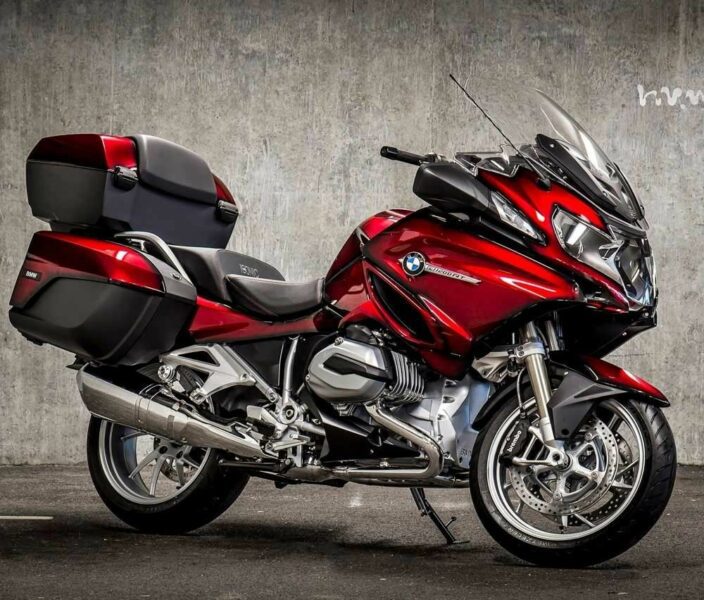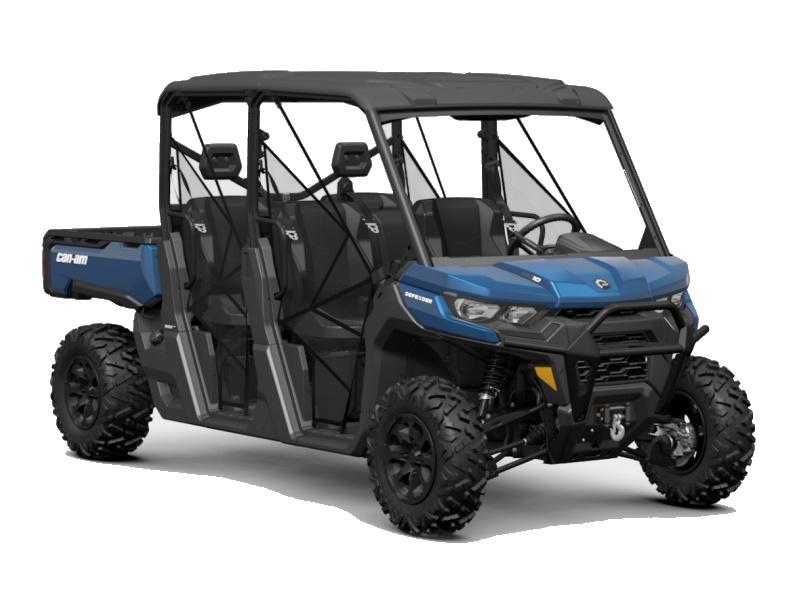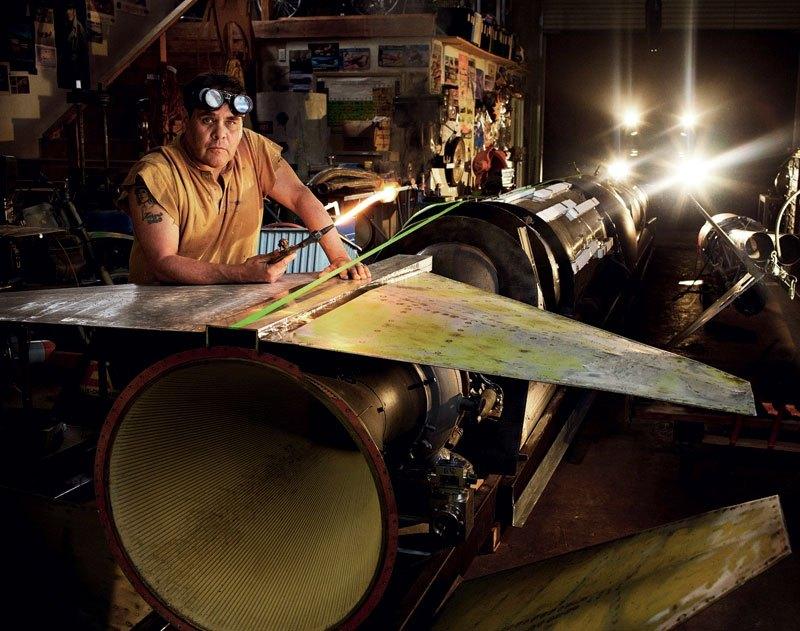
BMW R 1200 RT
Let's start with the previous model R 1150 RT. It was a motorcycle that, due to its versatility, served not only motorcyclists who love to travel, but also police officers. The old RT was distinguished by good wind protection, a fairly powerful engine and, of course, a large carrying capacity. Either way, whether loaded with holiday luggage or police gear, the bike was still easy and comfortable to drive.
Thus, the new R 1200 RT faces a daunting task as it should be an even better known and in many respects perfect travel predecessor. The novelty was equipped with a new generation boxer, which we were able to test last year on the large touring enduro R 1200 GS. An increase in engine power by 16% and a decrease in motorcycle weight by 20 kg significantly affect the ride quality. Thus, the new RT is more agile, faster and even easier to drive.
The 1.170 cc two-cylinder engine develops 3 hp and is very well distributed between 110 and 500 rpm. Electronics, of course, controls all engine operation. Thus, even in cold weather, it ignites flawlessly and automatically delivers the correct mixture of air and fuel, so that the engine runs smoothly at the right speed during heating. Convenience as a machine, no manual "chokes" and the like! So we were able to safely put on the helmet and gloves, and the engine warmed up on its own to operating temperature.
With the new ignition, they took care of savings, since fuel consumption at a constant speed of 120 km / h is only 4 liters per 8 kilometers, while the old model consumed 100 liters for the same distance. The engine also adapts to the different octane ratings of the gasoline. By factory standards, it is 5-octane gasoline, but if you can't find a gas station with such gasoline, you can also easily fill up with 5-octane gasoline. Electronics prevents any “knocking” or anxiety when the engine is running. The only difference in this case will be only a slightly lower maximum engine power.
While riding, we were delighted with the amount of torque that made it possible to mess around with the gearbox. The engine develops exemplary speeds from 1.500 rpm and does not require rotation above 5.500 rpm for smooth driving on a country road. The stock of power and torque, combined with a good gearbox, is more than enough. Speaking of the gearbox, here, as with the R 1200 GS last year, we can confirm the smooth and precise shifting. Lever movements are short, “missed” gears were not observed.
The gear ratios are calculated so that the bike accelerates from 0 to 100 km / h in just 3 seconds. It's not so touristy anymore, but it's sporty! Therefore, RT also hints at its liveliness by lifting the front wheel into the air during hard acceleration. But this is probably not so important anymore, since most riders ride this bike only a little calmer. Comfort is what really matters on this bike. Well, the latter you will find on it in abundance.
The suspension is good and technically advanced in BMW tradition. The front control lever provides precise steering control, preventing the bow of the motorcycle from shifting during hard braking. The RT braked perfectly, and for unpredictable terrain, it also features an ABS braking system, which in this case is partly an essential part of those who want a sportier driving experience from time to time. At the rear, it is equipped with a new Evo-Paralever system with the ability to adjust the suspension (shock preload), which in practice means quick and proper adjustment, depending on whether the motorcycle is riding only the driver or a passenger with all the luggage in their suitcases. The shock absorber worked precisely and silently, thanks also to the special progressive TDD (Travel-Dependent Damper) damper. This damping and damping system was first introduced on the R 1150 GS Adventure.
New to the RT is also the possibility of installing (as an accessory) Electronic Suspension Adjustment (ESA), which until now was only offered on the sporty K 1200 S. With this system, the driver can control the vehicle while driving, adjusting the suspension stiffness with a simple push of a button. adapted for a comfortable or sporty ride with or without a passenger.
The rider sits comfortably, relaxed and in a very natural posture while riding. This is why driving with it is tireless.
So, we drove 300 kilometers intact and in not the most pleasant weather. We realized that this is a first-class touring bike in the cold, when the on-board computer showed even -2 ° C. Despite the low temperatures on some parts of the road where we tested the RT, we never froze. An encouraging fact for all those who like to set off in early spring along the Dolomites or similar mountain roads filled with high mountain passes, where the weather, despite warmer conditions in the valley above, still shows teeth and sends short-term frost or snow.
Large armor with a large adjustable plexiglass windshield (electric, push-button) precisely because of its ability to instantly adapt, it perfectly protects the driver from the wind. We did not have a direct stream of air anywhere on the body or legs, with the minor exception of the thighs and feet. But even that, as has been said, did not bother. For comfort on RT, everything is in the right place. On the slower ride, we were also pampered by the radio with a CD player.
It is easy to operate, and the sound is stable up to 80 km / h. Above this speed, cruise control came to us, which is turned on by a simple push of a switch and turns off the sharper acceleration or deceleration. It sits in the back as well as in the front. Traditionally, the RT seat (heated at an additional cost) is in two parts and is height adjustable. With a very simple operation, the driver can select two seat heights from the ground: either 820 mm if its height is 180 centimeters, or 840 mm if it is one of the largest.
BMW has also thought about this for those who are short, as you can also choose between a seat height of 780 to 800 mm. In recent years, BMW has used a clever way of calculating ergonomics, as they take the measured distance from the left to the right foot along the inner leg length into account when determining the seat height from the ground. Therefore, getting to the ground is not difficult, despite the large size of the motorcycle.
Finally, a few words about the CAN-bus system and electronics. The new network connection with a single cable and fewer wire connections like in the past works similarly to cars where this system is already well established and everything else is just exotic (unlike motorcycles where it's the other way around). The advantages of this system are the simplicity of the design of the central electrical connection and the diagnostics of all important vehicle functions.
Classic fuses are a thing of the past in this BMW too! All the data that the computer receives through this system is visible on the screen in front of the driver on a large (almost car) dashboard. There, the driver also receives all the necessary data: engine temperature, oil, fuel level, range with the remaining fuel, current gear in the transmission, mileage, daily counter and time. That maintenance of electrical connections is really easy (with diagnostic equipment at an authorized service center, of course) is ensured by a sealed battery that does not require any maintenance.
With a new, highly advanced and modern design, the RT sets new standards in this class and others can only follow suit again. The two-cylinder boxer engine is a good drivetrain for everything a motorcycle is designed for (especially travel). It fits perfectly, has wind protection for one or two passengers, and offers a rich list of accessories, including quality suitcases that only enhance the look. In short, it is a first-class touring motorcycle.
But whether you can afford it is, of course, another question. Excellence costs. For the base model, 3.201.000 tolars must be subtracted, while the test RT (heated levers, cruise control, trip computer, radio with CD, alarm, etc.) amounted to "heavy" 4.346.000 tolars. Despite the large number, we still believe that the bike is worth the money. After all, BMWs are not for everyone.
Technical information
Test car price: 4.346.000 seats
Base model price: 3.201.000 seats
engine: 4-stroke, 1.170 cc, 3-cylinder, opposed, air-cooled, 2 hp at 110 rpm, 7.500 Nm at 115 rpm, 6.000-speed gearbox, propeller shaft
Frame: tubular steel, wheelbase 1.485 mm
Seat height from ground: 820-840 mm
Suspension: front body lever, rear single adjustable shock absorber parallel.
brakes: 2 drums with a diameter of 320 mm at the front and 265 mm at the rear
Tires: front 120/70 R 17, rear 180/55 R 17
Fuel tank: 27
Dry weight: 229 kg
Sales: Auto Active doo, road to Mestny Log 88a, 1000 Ljubljana, tel: 01/280 31 00
THANKS AND CONGRATULATIONS
+ appearance
+ motor
+ details
+ production
+ comfort
- turn signal switches
– Foot pedals are a bit cheap
Petr Kavčič, photo: Aleš Pavletič
Basic data
Base model price: 3.201.000 LED €
Test model cost: 4.346.000 SIT €
Technical information
engine: 4-stroke, 1.170 cc, 3-cylinder, opposed, air-cooled, 2 hp at 110 rpm, 7.500 Nm at 115 rpm, 6.000-speed gearbox, propeller shaft
Frame: tubular steel, wheelbase 1.485 mm
brakes: 2 drums with a diameter of 320 mm at the front and 265 mm at the rear
Suspension: front body lever, rear single adjustable shock absorber parallel.

